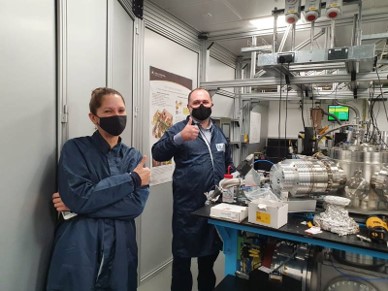The new laser uses
OPCPA technology to provide mid-infrared femtosecond pulses at 100 kHz repetition rate. For Artemis, the mid-infrared will enable the generation of higher photon energy XUV pulses and the higher repetition rate allows smaller samples to be studied. For Ultra, the appeal is the ability to provide broader spectral coverage at high repetition rates, for faster data acquisition, and more efficient generation of mid- to far-IR pulses.
Lab-space
The smaller of the two labs holds our two laser systems, while the larger lab holds three parallel XUV beamlines, and IR spectroscopy stations for Ultra. A custom-built external plant room holds chillers, cryo-compressors and backing pumps to minimise the noise levels in the lab.

The new Artemis labs, showing the ARPES and AMO end-stations (left and centre respectively). The imaging beamline is nearest to the camera, and the 1kHz monochromatised beamline is behind it.
100 kHz IR laser
The new laser system is a
100 kHz OPCPA system from Fastlite. The system has several outputs: a femtosecond CEP-stable fixed-wavelength mode for HHG, a tunable mode that is more suitable for IR spectroscopy, as well as a picosecond tunable mode. The laser system is pumped by a Yb:YAG system from Trumpf Scientific, based on an industrial micro-machining system.
100 kHz OPCPA system in the new laser lab.
1 kHz Ti:Sapphire laser
The existing Artemis
1 kHz RedDragon laser has been upgraded with a third amplifier stage to provide 2 x 8 mJ pulses. This will enable us to offer HHG with second or third harmonic drive in conjunction with tuneable outputs from the Topas OPA system, or to further amplify the output of the OPA or hollow fibre.
1 kHz Ti:Sapphire system fully re-installed in the new laser lab.
.
New beamlines
A
new XUV beamline for the 100 kHz laser system has been built. It includes a flat-field spectrometer and a monochromator. The
time-resolved ARPES experiments now run on this new beamline.
The new 100 kHz XUV beamline.
IR spectroscopy stations
Ultra will develop IR spectroscopy stations, to allow us to initially evaluate the performance of the stable, broadband mid-IR (> 4 µm) output of the new system. As well as the appeal of using such a source for ultrafast IR spectroscopy, the narrowband (~ 20 cm-1) pump laser opens up new opportunities in ultrafast Raman and unique hybrid narrowband/broadband capability, such as surface sum frequency generation and multidimensional spectroscopy techniques (e.g. electronic-vibrational-vibrational).
Current status
The 100 kHz laser system and 100 kHz beamline have now been fully commissioned, and we have now demonstrated Tr-ARPES at 100 kHz with reduced spot size and space charge. We have also successfully used the 1 micron, ps pump pulses in a joint experiment with Ultra on high-power Kerr-gated Raman spectroscopy.
The 1 kHz laser is up and running, and we are now running user experiments. The 1 kHz monochromatised beamline has been fully recommissioned with new XUV optics. We measure an order of magnitude higher XUV flux compared to the old Artemis beamline.
We are now running normally with a full complement of staff in the labs and users back on site.

The first user experiment in the new Artemis labs in Oct 2020. Our first user was former Artemis team member Cephise Cacho, now at Diamond. The rest of the team participated remotely from France. Beamline scientists were Charlotte Sanders (pictured) and Yu Zhang.
